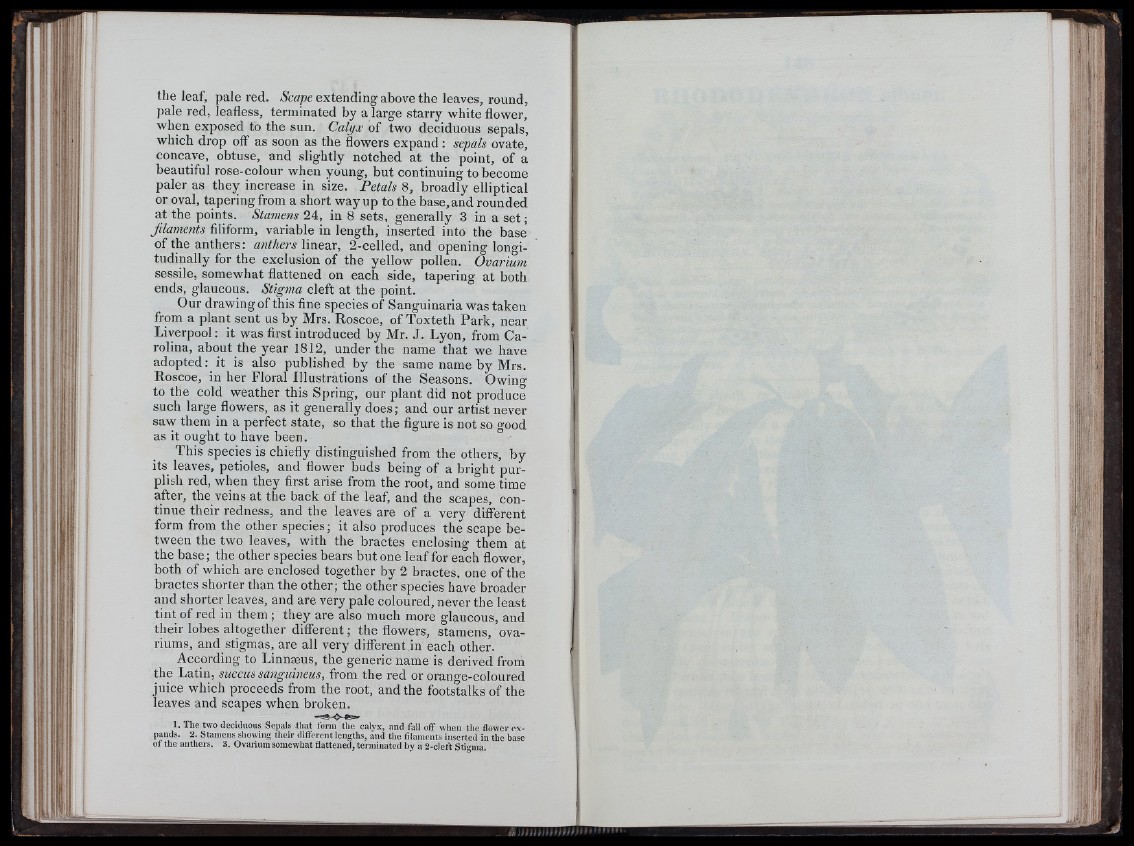
the leaf, pale red. extending above the leaves, round,
pale red, eafless, terminated by a large starry white flower,
when exposed to the sun. Calyx of two deciduous sepals,
which drop off as soon as the flowers expand : sepals ovate,
concave, obtuse, and slightly notched at the point, of a
beautiful rose-colour when young, but continuing to become
paler as they increase in size. Petals 8, broadly elliptical
or oval, tapering from a short way up to the base,and rounded
at the points. Stamens 24, in 8 sets, generally 3 in a set ;
Jilaments filiform, variable in length, inserted into the base
of the anthers: anthers linear, 2-celled, and opening longitudinally
for the exclusion of the yellow pollen. Ovarium
sessile, somewhat flattened on each side, tapering at both
ends, glaucous. Stigma cleft at the point.
Our drawing of this fine species of Sanguinaria was taken
from a plant sent us by Mrs. Roscoe, of Toxteth Park, near
Liverpool: it was first introduced by Mr. J. Lyon, from Carolina,
about the year 1812, under the name that we have
adopted: it is also published by the same name by Mrs.
Roscoe, in her Floral Illustrations of the Seasons. Owing
to the cold weather this Spring, our plant did not produce
such large flowers, as it generally does ; and our artist never
sa\y them in a perfect state, so that the figure is not so good
as it ought to have been.
This species is chiefly distinguished from the others, by
its leaves, petioles, and flower buds being of a bright purplish
red, when they first arise from the root, and some time
after, the veins at the back of the leaf, and the scapes, continue
their redness, and the leaves are of a very different
form from the other species; it also produces the scape between
the two leaves, with the bractes enclosing them at
the base ; the other species bears but one leaf for each flower,
both of which are enclosed together by 2 bractes, one of the
bractes shorter than the other; the other species have broader
and shorter leaves, and are very pale coloured, never the least
tint of red in them ; they are also much more glaucous, and
their lobes altogether different ; the flowers, stamens, ova-
riums, and stigmas, are all very different in each other.
According to Linnæus, the generic name is derived from
the Latin, succus sanguineus, from the red or orange-coloured
juice which proceeds from the root, and the footstalks of the
leaves and scapes when broken.
1. The two deciduous Sepals that form the calyx, and fall o ff when th e flower e x pands.
2 . Stamens showing their different lengths, and the iilaments inserted in the base
of the anthers. 3. Ovarium somewhat flattened, terminated by a 2 -cle ft Stigma.
Ml
I
! , j: ll
i'ii